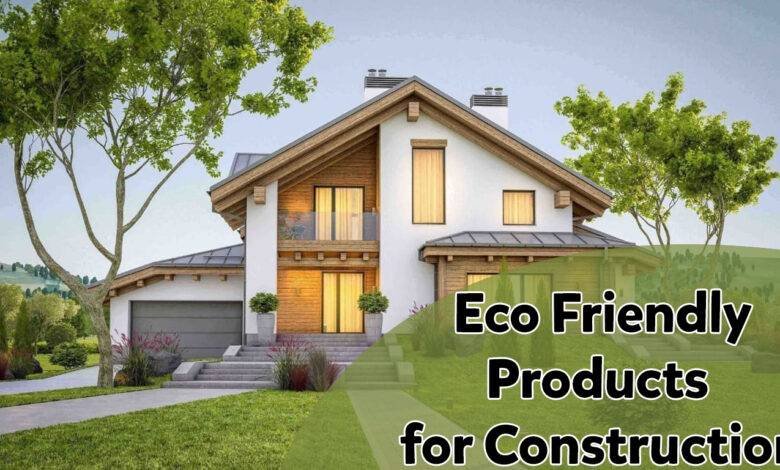Eco-Friendly Products for Construction: Building a Sustainable

Eco-Friendly Products for Construction: Building a Sustainable Future
Table of Contents
- Introduction
- The Importance of Eco-Friendly Construction
- Sustainable Building Materials
- 3.1 Recycled Concrete
- 3.2 Bamboo
- 3.3 Reclaimed Wood
- 3.4 Insulated Concrete Forms (ICFs)
- 3.5 Solar Panels
- Green Roofing Options
- 4.1 Living Roofs
- 4.2 Cool Roofs
- 4.3 Metal Roofs
- Energy-Efficient Windows and Doors
- 5.1 Double or Triple Glazing
- 5.2 Low-E Glass
- 5.3 Energy-Efficient Doors
- Smart Home Technology for Energy Management
- Water-Saving Fixtures and Systems
- Efficient Heating, Ventilation, and Air Conditioning (HVAC)
- Conclusion
- FAQs
1. Introduction
In the pursuit of a sustainable future, the construction industry plays a pivotal role. With the rising awareness of environmental concerns, the demand for eco-friendly construction practices and products has significantly increased. This article explores various eco-friendly products that can be used in construction, promoting sustainability and reducing the environmental impact of buildings.
2. The Importance of Eco-Friendly Construction
Eco-friendly construction focuses on minimizing the use of non-renewable resources, reducing waste, and optimizing energy efficiency. By adopting sustainable practices and utilizing environmentally friendly products, the construction industry can contribute to mitigating climate change, conserving resources, and creating healthier living environments.
3. Sustainable Building Materials
3.1 Recycled Concrete
Recycled concrete is an eco-friendly alternative to traditional concrete. By incorporating recycled aggregate, such as crushed concrete, in the mix, the demand for new raw materials is reduced. This not only conserves natural resources but also diverts construction waste from landfills.
3.2 Bamboo
Bamboo is a highly sustainable building material due to its rapid growth and renewability. It can be used for various applications, including flooring, wall panels, and even structural elements. Bamboo’s strength, durability, and aesthetic appeal make it a popular choice among eco-conscious builders.
3.3 Reclaimed Wood
Using reclaimed wood from salvaged sources helps minimize deforestation and promotes the reuse of existing materials. Reclaimed wood can be repurposed for flooring, furniture, or decorative elements, adding character and warmth to a construction project while reducing the demand for newly harvested timber.
3.4 Insulated Concrete Forms (ICFs)
Insulated Concrete Forms (ICFs) are energy-efficient building blocks made of expanded polystyrene (EPS) or other insulating materials. They provide excellent thermal insulation, reducing heating and cooling requirements in buildings. ICFs also enhance soundproofing capabilities and offer increased durability.
3.5 Solar Panels
Solar panels are a sustainable energy solution for construction projects. They harness sunlight to generate clean and renewable electricity, reducing reliance on conventional energy sources. Solar panels can be integrated into roofs or installed as separate systems, contributing to lower energy costs and a smaller carbon footprint.
4. Green Roofing Options
4.1 Living Roofs
Living roofs, also known as green roofs, involve the installation of vegetation on building rooftops. They provide numerous environmental benefits, including improved air quality, increased insulation, stormwater management, and the creation of habitats for wildlife. Living roofs also enhance the aesthetic appeal of buildings.
4.2 Cool Roofs
Cool roofs are designed to reflect sunlight and absorb less heat compared to traditional roofs. They are typically made of reflective materials or coatings that minimize heat transfer. By reducing the heat island effect, cool roofs contribute to energy savings and a more comfortable indoor environment.
4.3 Metal Roofs
Metal roofs are a durable and eco-friendly roofing option. They are often made from recycled materials, such as steel or aluminum, and can be recycled at the end of their lifespan. Metal roofs are long-lasting, energy-efficient, and can withstand extreme weather conditions, making them a sustainable choice for construction projects.
5. Energy-Efficient Windows and Doors
5.1 Double or Triple Glazing
Double or triple glazing refers to the use of multiple glass panes with insulating layers in windows. These glazing systems enhance thermal insulation, minimize heat transfer, and reduce energy loss. Energy-efficient windows contribute to improved indoor comfort, reduced energy consumption, and lower utility bills.
5.2 Low-E Glass
Low-emissivity (Low-E) glass coatings are designed to reflect heat while allowing natural light to pass through. This type of glass minimizes the transfer of heat between the interior and exterior of a building, contributing to energy efficiency and climate control.
5.3 Energy-Efficient Doors
Energy-efficient doors are constructed with insulated cores and weatherstripping to prevent air leakage. They provide a tight seal, reducing drafts and heat loss. Energy-efficient doors are essential for maintaining a comfortable indoor environment and reducing energy consumption for heating and cooling.
6. Smart Home Technology for Energy Management
Smart home technology enables homeowners to monitor and control energy usage efficiently. By integrating devices such as smart thermostats, automated lighting systems, and energy management software, construction projects can optimize energy consumption, lower costs, and minimize environmental impact.
7. Water-Saving Fixtures and Systems
Water-saving fixtures and systems help conserve water in construction projects. Low-flow toilets, water-efficient faucets, and rainwater harvesting systems are examples of eco-friendly options. These measures reduce water waste and contribute to sustainable water management.
8. Efficient Heating, Ventilation, and Air Conditioning (HVAC)
Efficient HVAC systems are essential for maintaining comfortable indoor environments while minimizing energy consumption. Energy-efficient heating and cooling technologies, such as geothermal heat pumps and high-efficiency air conditioners, promote sustainability and reduce greenhouse gas emissions.
9. Conclusion
The adoption of eco-friendly products in construction is a significant step towards building a sustainable future. By using sustainable building materials, implementing energy-efficient systems, and embracing smart technologies, the construction industry can contribute to mitigating climate change, conserving resources, and creating healthier and more environmentally friendly buildings.
See More Interesting Construction Articles Click Here
Join Telegram Channel Click Here








